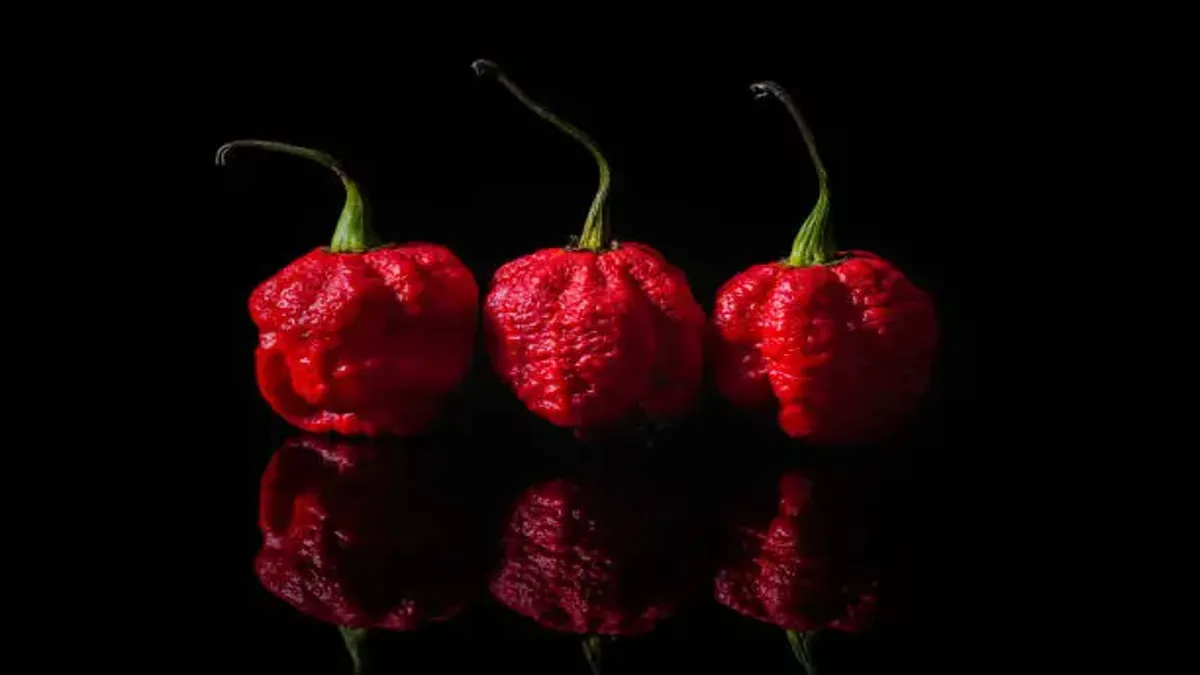When readers search for “Carolina Reaper pepper Scoville units,” they’re seeking clarity on what makes this chili so extraordinarily hot, how its heat is measured, and why it has captivated global fascination. Within the first hundred words, here’s the essential answer: the Carolina Reaper pepper—a hybrid chili developed in South Carolina—holds a record-breaking Scoville Heat Unit (SHU) rating that averages around 1,641,183 SHU, with peaks surpassing 2.2 million SHU. This rating quantifies its fiery intensity, placing it far above everyday hot peppers like jalapeños or habaneros. Yet behind the numbers lies a complex story of human endurance, agricultural innovation, and the psychological thrill of spice.
The Carolina Reaper’s fame isn’t only about pain—it’s about balance: between heat and sweetness, danger and curiosity, culinary daring and scientific measurement. It represents how humans chase sensory limits, turning discomfort into a cultural phenomenon.
The Origin Story of the Carolina Reaper
The Carolina Reaper was created by Ed Currie, a grower and spice enthusiast from South Carolina who runs the PuckerButt Pepper Company. His goal wasn’t just to break records but to explore capsaicin—the compound that gives peppers their heat—for potential health benefits.
“I wasn’t chasing pain; I was chasing perfection,” said Currie in an interview about his creation.
The pepper is a crossbreed between a Pakistani Naga pepper and a Red Habanero, resulting in a unique blend of sweet, fruity flavor and explosive heat. Its gnarled surface, scorpion-like tail, and deep red hue make it as visually intimidating as it tastes.
The name Carolina Reaper reflects both its place of origin and its formidable heat—“Reaper” implying that it brings mortals close to their limits.
The Scoville Scale: Measuring the Heat of Fire
To understand why the Carolina Reaper stands out, one must first understand the Scoville scale, the metric for quantifying chili heat. Developed in 1912 by American chemist Wilbur Scoville, the scale measures the concentration of capsaicin, the chemical responsible for the burning sensation.
Originally, Scoville’s test relied on human tasters who diluted chili extracts until they could no longer detect heat—a method subjective but foundational. Today, laboratories use High-Performance Liquid Chromatography (HPLC) to measure exact capsaicinoid content, converting results into SHU values.
Scoville Units Breakdown:
- Jalapeño: 2,500–8,000 SHU
- Habanero: 100,000–350,000 SHU
- Ghost Pepper (Bhut Jolokia): 855,000–1,041,000 SHU
- Trinidad Moruga Scorpion: 1,200,000–2,009,231 SHU
- Carolina Reaper: 1,641,183 average, peak over 2,200,000 SHU
“The Scoville scale is the thermometer of human courage,” wrote a food scientist, “measuring how far curiosity can overcome fear.”
At the top of this spectrum, the Carolina Reaper is less a seasoning and more an experience—a chemical encounter with intensity itself.
Table 1: Comparison of Pepper Scoville Ratings
| Pepper Type | Average SHU (Scoville Heat Units) | Peak SHU | Flavor Notes |
|---|---|---|---|
| Jalapeño | 5,000 | 8,000 | Bright, grassy, mild |
| Cayenne | 40,000 | 50,000 | Earthy, sharp |
| Habanero | 200,000 | 350,000 | Fruity, floral |
| Ghost Pepper | 1,000,000 | 1,041,000 | Smoky, pungent |
| Trinidad Scorpion | 1,500,000 | 2,000,000 | Fiery, bitter-sweet |
| Carolina Reaper | 1,641,183 | 2,200,000+ | Sweet, fruity, terrifyingly hot |
The Science of Capsaicin: Why It Burns
Capsaicin is not heat in the physical sense—it’s chemistry tricking biology. It binds to TRPV1 receptors in the mouth and skin, the same receptors that detect physical heat or abrasion. The brain interprets this as burning, even though no tissue damage occurs.
What Happens in the Body:
- Contact: Capsaicin molecules bind to pain receptors on the tongue.
- Signal: The brain interprets the stimulus as heat or injury.
- Response: The body releases endorphins and dopamine to counteract pain, creating a brief euphoric sensation.
- Aftermath: The body cools itself through sweating, salivation, and sometimes tears.
“Pain and pleasure share a border, and chili peppers sit right on the fence,” wrote a neurologist studying spice addiction.
This explains why spicy food lovers often describe the experience as exhilarating rather than unbearable. The Carolina Reaper pushes this phenomenon to its biological limits.
Flavor Beyond the Fire: The Carolina Reaper’s Taste Profile
Despite its fearsome reputation, the Carolina Reaper isn’t merely hot—it’s surprisingly flavorful. Many describe its initial sweetness, akin to cherry or cinnamon, before the heat rapidly overwhelms the palate.
Flavor Notes of the Carolina Reaper:
- Initial: Fruity sweetness with tropical undertones.
- Mid-Palate: Gradual emergence of smoky bitterness.
- Finish: Prolonged, explosive heat lasting 10–20 minutes.
“It’s like a beautiful song that ends with an earthquake,” one chef remarked.
When used in moderation, its flavor complexity enhances sauces, salsas, and even desserts. However, when consumed directly, the heat dominates, leaving only memory and adrenaline.
Culinary Uses: From Challenge to Craft
In the culinary world, the Carolina Reaper’s reputation often precedes its application. While viral “pepper challenges” dominate social media, professional chefs approach it with restraint, incorporating minute quantities for controlled intensity.
Culinary Applications:
- Hot sauces and chili pastes.
- Meat marinades for depth and sweetness.
- Powdered spice blends for stews and barbecue.
- Infused oils and vinegars for adventurous palettes.
- Spicy chocolates and novelty snacks.
“You don’t use the Reaper to burn—you use it to wake the tongue,” said a South Carolina chef.
The balance lies in respecting the pepper’s potency. Too much can overpower; too little can miss its layered depth.
Table 2: Culinary Use vs. Recommended Quantity
| Dish Type | Recommended Use | Flavor Outcome |
|---|---|---|
| Hot Sauce | 1–2 grams per liter | Sweet heat, lasting burn |
| Marinade | 0.5 gram per kilogram of meat | Smoky undertone, balanced spice |
| Stew | A pinch for 4 servings | Deep warmth without overpowering |
| Snack Coating | Minimal dusting | Piquant bite |
| Chocolate | Microdose infusion | Sweet-spicy contrast |
The Guinness Record and Global Recognition
In 2013, the Guinness World Records officially recognized the Carolina Reaper as the world’s hottest chili. Even a decade later, it continues to hold that title against contenders like the Dragon’s Breath and Pepper X (both under ongoing review) – carolina reaper pepper scoville units.
Its global popularity skyrocketed due to YouTube challenges, cooking competitions, and spicy food festivals. Videos of people attempting to eat a single Carolina Reaper—often followed by dramatic coughing, sweating, or tears—turned it into a pop culture icon.
“It’s the Everest of spice—people climb it not to eat, but to prove they can,” quipped a culinary journalist.
Yet behind the theatrics lies a genuine appreciation for cultivation and craftsmanship. Each pepper represents years of genetic refinement and agricultural patience.
Health Aspects: Danger and Benefits
Despite its intensity, the Carolina Reaper has surprising health properties when consumed responsibly. Capsaicin has been studied for its anti-inflammatory, metabolic, and analgesic effects. However, overconsumption or direct contact can cause discomfort and, in rare cases, medical emergencies.
Potential Health Benefits:
- Boosts metabolism and fat oxidation.
- Contains antioxidants that combat cell damage.
- Promotes endorphin release, improving mood.
- Aids digestion by stimulating gastric juices.
Cautionary Notes:
- Can cause nausea, vomiting, or stomach irritation if eaten raw.
- Direct eye or skin contact can trigger severe burning sensations.
- Should not be consumed by individuals with gastrointestinal conditions.
“Spice is medicine until it becomes obsession,” warned a nutritionist.
Moderation and respect define safe enjoyment. Even microdoses of Carolina Reaper extract can flavor dishes without risking harm.
The Global Spice Economy: Cultivating Heat
The demand for ultra-hot peppers has grown dramatically in the last decade. Farmers in the U.S., India, and South America now cultivate specialized high-capsaicin varieties for both culinary and medical use – carolina reaper pepper scoville units.
Economic Highlights:
- Carolina Reaper seeds can sell for over $1 per seed.
- Powder and sauces fetch premium export prices.
- Capsaicin extracts are used in pain relief gels and pepper sprays.
The global “heat economy” is a blend of tradition and science—fueled by both food culture and pharmaceutical research.
“We’re not just farming heat; we’re cultivating curiosity,” said Ed Currie in a business forum.
In regions like South Carolina, the Carolina Reaper has become both a local identity and a symbol of agricultural innovation.
The Cultural Fascination with Pain and Pleasure
Why do people seek out the world’s hottest pepper when it clearly causes discomfort? Psychologists refer to this as “benign masochism”—a paradox where the brain enjoys controlled discomfort because it knows it’s safe.
Psychological Triggers Behind Spicy Challenges:
- Endorphin High: Capsaicin-induced pain releases pleasure hormones.
- Achievement: Surviving the burn feels like conquering a mountain.
- Social Bonding: Shared suffering fosters community and humor.
- Identity Expression: Daring eaters express courage and individuality.
“Pain, when chosen, becomes pleasure,” noted a behavioral scientist.
This explains why Carolina Reaper contests continue to attract global audiences—the experience isn’t just physical but deeply emotional.
Environmental Factors and Agricultural Precision
Growing Carolina Reapers requires precision. The pepper thrives in warm, humid climates with abundant sunlight and well-drained soil. Consistent care determines both flavor and heat.
Ideal Growing Conditions:
- Temperature range: 75°F–95°F (24°C–35°C)
- Soil pH: 6.0–6.5
- Growth duration: 90–120 days
- Watering: Deep, consistent hydration without saturation
Farmers must harvest carefully—ripe Reapers can blister skin on contact. Their signature scorpion tail forms only under optimal heat conditions, making every batch a product of skill and timing.
“Each pod is a living record of the summer that made it,” said a Carolina farmer.
Sustainability also plays a role—organic cultivation reduces environmental stress while preserving the pepper’s authenticity.
Bullet Points: Key Facts About Carolina Reaper Scoville Units
- Officially rated 1,641,183 SHU average; peaks beyond 2,200,000 SHU.
- Created by Ed Currie in South Carolina from hybrid chili strains.
- Recognized as the world’s hottest pepper by Guinness World Records (2013).
- Balances intense heat with fruity sweetness.
- Used in sauces, powders, chocolates, and culinary experiments.
- Capsaicin content offers both health benefits and cautionary risks.
- Symbolizes human fascination with sensory extremes.
- Cultivation requires tropical conditions and precision farming.
The Legacy: More Than Just a Hot Pepper
The Carolina Reaper is not simply a culinary novelty—it’s a symbol of human experimentation and endurance. It reflects how far we push nature and ourselves in pursuit of intensity. Beyond its blistering heat, it’s a story of passion, precision, and purpose—a microcosm of creativity that connects farmers, chefs, and thrill-seekers alike – carolina reaper pepper scoville units.
“The Carolina Reaper isn’t about suffering—it’s about discovery,” said a food anthropologist.
It bridges science and culture, showing that even in discomfort lies artistry. Its Scoville number may quantify heat, but it cannot quantify courage, curiosity, or the endless human desire to taste the impossible.
Conclusion: The Measured Madness of the Carolina Reaper
The Carolina Reaper pepper’s Scoville dominance is not just a record—it’s a revelation. It demonstrates that measurement and meaning can coexist, that something as fleeting as flavor can evoke wonder, challenge, and community. From laboratories to dinner tables, from scientific instruments to viral screens, its heat unites people through shared awe.
“In every pepper, there’s a story of risk and reward,” wrote a Times food columnist.
Ultimately, the Carolina Reaper teaches a profound lesson: limits exist only to be explored. Whether admired for its beauty, respected for its danger, or tasted for its legend, it stands as the embodiment of both nature’s fire and humanity’s endless appetite for experience – carolina reaper pepper scoville units.
Frequently Asked Questions (FAQs)
1. What makes the Carolina Reaper so hot?
Its high capsaicin concentration—averaging 1.6 million SHU—is due to crossbreeding and optimal growing conditions.
2. Can eating a Carolina Reaper be dangerous?
For most people, it’s safe in small amounts. However, eating it whole may cause severe discomfort or digestive distress.
3. How does it compare to a ghost pepper?
The Carolina Reaper is roughly twice as hot as a ghost pepper, but with a sweeter flavor profile.
4. Is the Carolina Reaper used for anything besides food?
Yes, capsaicin from Reapers is used in medical pain relief products and defensive sprays.
5. What’s next after the Carolina Reaper?
New hybrids like Pepper X and Apollo aim to push Scoville boundaries further, though none have surpassed it officially.











